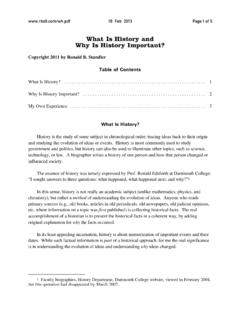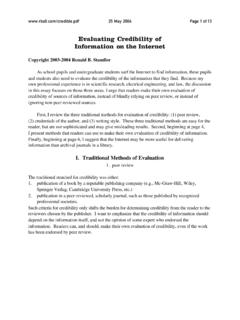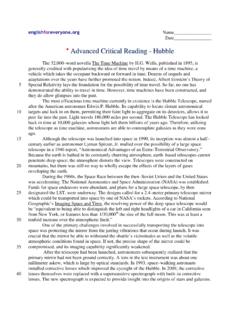Transcription of Funding of Basic Research in Physical Science in the …
1 Jan 2009 Page 1 of 13 Funding of Basic Researchin Physical Science in the USAC opyright 2004 by Ronald B. StandlerTable of ContentsIntroduction .. 2 World War II .. 31950s and 1960s .. 3 Decline in 1970s, 1980s, and in 1990 .. 41. Vietnam war .. 42. Retirement of World War II era officers .. 43. Gramm-Rudman-Hollings Act .. 54. End of Cold War in 1990 .. 5 Effects of these budget cuts .. 5 Better Motivation for Scientific Research .. 6 Scientists are easy for politicians to ignore .. 7failure of universities .. 9politics .. 10 Addendum in 2009 .. 11 Links to Other Resources .. 12 Conclusion .. Jan 2009 Page 2 of 13 IntroductionThis essay gives a short history of the Funding of Research in Science and engineering by Government from about 1940 to 2000. This story is worth telling because it shows thebetrayal of creative intellectuals in Science and engineering by members of the Congress andby Government began my studies in physics in 1967, earned a in physics in 1977 after ten years ofcontinuous full-time university study and Research , then worked as an electrical engineer from1977 until 1990, because there were few employment opportunities for physicists.
2 Because of theannihilation of financial support for scholarly Research in all of my fields of Science andengineering in 1990 ( , the so-called peace dividend ), I became an attorney in 1998. As apracticing scientist or engineer during the 1970s and 1980s, who was funded mostly by military, I personally experienced the effects of the political problems described in this essay. My insight into the motivation of the military comes largely from my discussions withmilitary officers during the 1980s, particularly during a sabbatical year that I spent at the AirForce Weapons Laboratory in Albuquerque, NM during 1983-84. To prevent this essay frombeing considered sour grapes, I do not mention my personal experience in the following essay. I do not have the time to provide oodles of footnotes to sources, although I suggest below,at page 12, where such information can be the years 1920-45, Robert Goddard was a professor of physics at Clark University inMassachusetts, who was interested in developing liquid-fuel In 1930, he created alaboratory and test range in the New Mexico desert, near Roswell, where there was little risk of fireto buildings from his rockets.
3 He was continually plagued by difficulties in obtaining financialsupport for his work. Most of Goddard's early Funding came from his own pocket, plus modestgrants from the Smithsonian Institution and the Carnegie Institution. Between 1930 and 1941, theGuggenheim Foundation gave him larger grants. The military repeatedly refused to sponsorhis Research between the two World Wars, despite the obvious application of such rockets towarfare. German engineers who were developing rockets ( , the V-2) during World War IIcarefully studied Goddard's publications and patents. In the 1950s, the Government infringeda number of Goddard's patents on liquid-fuel propulsion and gyroscopic stabilization. It seemsparticularly ironic that the same Government who refused to support Goddard's Research , then laterwrongfully appropriated Goddard's best ideas. Goddard died in 1945. But, after a nine year legalbattle that ended in 1960, his widow and the Guggenheim Foundation received from Government what was, at that time, the largest monetary settlement of patents infringed bythe Government.
4 This vignette shows the attitude of the Government toward scientists:don t support their Research , then steal their ideas. Dr. Goddard could have accomplished muchmore in his short life, if he had been given adequate financial See the biography at . Jan 2009 Page 3 of 13 World War IIPrior to World War II, governments rarely directly funded scientific Research . Research wassomething that university professors did in their spare ( , nonteaching) time. A few wealthypeople ( , Benjamin Franklin, Lord Rayleigh) did Research that was financed by their personalmoney. One lesson learned by all military officers during World War II was the critical importance oftechnology in military campaigns. During the few years of World War II, a number of importantinnovations were developed and put into use. Radar allowed ships to see in fog and radar gaveadvance warning of bomber raids and missile attacks.
5 The use of proximity fuses in anti-aircraftartillery shells greatly increased the ability to defend against bomber raids. The development ofaccurate bombsights contributed to the destruction of Germany and Japan. And, of course, thedevelopment of nuclear weapons quickly ended the war against Japan. In short, such technologysaved the lives of American military and shortened World War II. Two famous programs were (1) the Manhattan Project at Los Alamos, NM that developed thefirst atomic bomb and (2) the Radiation Laboratory at MIT that developed radar systems andmicrowave electronic devices. Most of the scientists in these two programs were physicsprofessors and graduate students in physics. In other words, these military programs wereessentially composed of academics and students, who were temporarily borrowed fromuniversities. This began the collaboration between universities and the military.
6 Incidentally,the University of California held the contract to manage the Los Alamos Scientific Laboratorysince 1943. 1950s and 1960sDuring the 1950s and 1960s, the Government, mostly though its military, wasresponsible for Funding an enormous amount of scientific and engineering Research . Much of theresearch was pure , not directed at solving a practical problem of interest to the military. But even this allegedly irrelevant pure Research played a vital need in the defense of the freeworld by continuing to keep university professors working on the cutting edge of their field and bypaying for graduate education of many scientists and engineers who worked on Research projectssponsored by the military. Many of the young graduates then began a career working for industry,or in government laboratories, producing new weapons technology. The USSR, which threatened Europe along the Iron Curtain, and communist China, whichthreatened South Korea and Southeast Asia, both had armies that were enormously larger than thearmy of the USA.
7 The USA planned to defeat either the USSR or communist China in battle, byusing advanced technology that made each one of our soldiers more effective than the Jan 2009 Page 4 of 13effort of dozens of enemy soldiers, a doctrine known in American military jargon as forcemultipliers . The senior officers in the military during the 1950s and 1960s were personally aware ofthe role that physics professors had played during World War II in developing critical militarytechnology, and these grateful officers saw these professors as a national resource. By generouslyfunding Basic scientific Research , the military kept these professors ready to contribute to afuture war effort, and encouraged universities to expand physics and engineering departments. Decline in 1970s, 1980s, and in 1990 Four unrelated events in the 1970s and 1980s merged and caused the decimation of financialsupport for Basic scientific Research in many areas of physics and Vietnam warThe disenchantment with the military in the 1970s, during the Vietnam War, lead to drasticreductions in Research sponsored by the military.
8 In the early 1970s there were many protestdemonstrations on university campuses that opposed the university s acceptance of contracts orgrants from the Department of Defense, regardless of the topic of the Research . That shift awayfrom military sponsorship would have been of little consequence, except that there was nocorresponding increase in Funding by civilian agencies, such as the National Science Foundation(NSF) and NASA. I mention in passing that the environmental movement that flourished in the1970s often simplistically portrayed Science and technology as the cause of pollution,2 which mayhave contributed to some people s reaction against Science and engineering. 2. Retirement of World War II era officersA young military officer who was 22 y old in 1941 was 65 y old in 1984. The senior officerswho were personally grateful for technology in World War II retired, and then were no longer ableto insist on generous financial support of scientific Research .
9 Their younger replacements hadalways been around transistors, radar, rockets, nuclear weapons, and other military technology,so they did not appreciate the role of creative scientists and engineers in producing this A more accurate statement would be that pollution is caused by the misuse of Science andtechnology. Science gives us opportunities, and people may choose through ignorance, greed, orapathy to misuse those Jan 2009 Page 5 of 13 3. Gramm-Rudman-Hollings ActPresident Ronald Reagan presided over large military spending, much of it for the pipedreamof the so-called Star Wars shield against incoming ballistic missiles. As a result of continuing,large federal budget deficits, the Gramm-Rudman-Hollings Act3 was passed in December 1985that promised to balance the federal budget by October 1990. The Gramm-Rudman Act is a nowforgotten failure: despite the promise of that Act, the Government did not have a single yearwith a balanced budget until the year 1998, eight years after the Gramm-Rudman target.
10 What theGramm-Rudman Act did accomplish was to drastically reduce the federal government s financialsupport for scientific and engineering Research , because there was no articulate and politicallypowerful voice that defended Research from the budget axe. As a result of the Gramm-RudmanAct, many Government agencies did not have enough allocated funds to honor their pastcontractual obligations to universities and other Research organizations, so few new researchcontracts were funded during End of Cold War in 1990 The end of the Cold War around 1990, with the economic and political collapse of the formerSoviet Union, the fall of the Berlin Wall, and the merger of East and West Germany, was seen bymany politicians in the USA as an indication that we no longer needed a large military. Manypoliticians gleefully declared a peace dividend and further reduced the Funding for both military and scientific Research .





